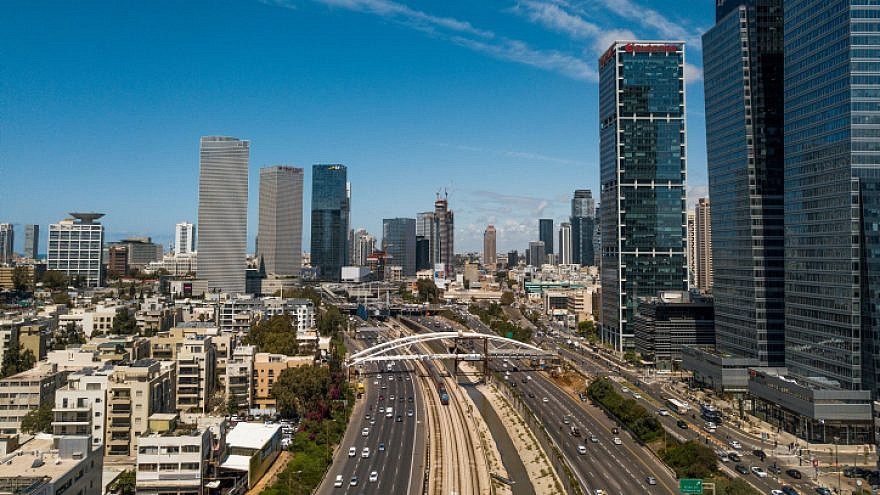In an article last week about refugees in the Gaza Strip yearning to return to their family homes, now located in Israel, Reuters misrepresented Tel Aviv as an Arab city prior to 1948.
In the article, titled “Gaza fisherman clings to dream of return to Jaffa home,” author Nidal al-Mughrabi writes: “Mahmoud Al-Assi comes often to this blue bench. It is one of more than 120 such brightly-coloured concrete seats that line the Gaza seafront, each marked with the name of a town or village in Palestine, before Israel’s creation in 1948.
“Like many of Gaza’s 1.3 million refugees, Assi, 73, visits the coastal benches regularly, as an emotional link to the towns their families left behind or were forced to leave.”
Unlike Akka and Bir as-Saba’—Arabic names for Acre and Beersheba, respectively, that were in use throughout the twentieth century—there was never a place called Tel ar-Rabeea’ before 1948. That term is merely the literal Arabic translation of the Hebrew name Tel Aviv. As the “first Hebrew city” in the era of Zionism, its Jewish inhabitants adopted its name as early as 1910, based on Nahum Sokolov’s Hebrew translation of Theodor Herzl’s Altneuland; “Tel Aviv” appears in the Book of Ezekiel.
The introduction of Tel al-Rabeea’ into the nomenclature of Palestinian place names, primarily in the context of nakba (“catastrophe,” referring to the creation of the State of Israel) commemoration and the demand for the return to Israel of refugees and their descendants, is a means to bolster the false claim that there was a Palestinian town by that name. This claim first emerged in 2010 in both the West Bank and Gaza, and by 2017 had made its way into Palestinian schoolbooks.
This falsehood is also perpetuated in the Reuters report, where the Palestinian use of the name is recited uncritically and without further explanation. Thus, from the context in the article, it is clear that the benches commemorate the Palestinian exodus in 1948; why would any of them bear the name of a city that was entirely Jewish until 1948 if not to claim that it, too, was actually Arab?
Even Palestinian advocates of the so-called “right of return” have acknowledged that the very use of “Tal ar-Rabeea’” is sufficient to suggest the existence of an Arab city or town that was never there. According to an editorial from 2012 by the Nazareth-based website Arab 48 (translation by CAMERA Arabic):
“It has become commonplace to use the ‘Tal ar-Rabeea” phrase as an Arabic alternative for the name of the city of Tel Aviv … The name implies that a Palestinian city or town by the name of ‘Tal ar-Rabeea” [had existed] before the nakba of 1948, and that now Tel Aviv stands on its ruins, like many Palestinian cities and towns whose population was made to emigrate, and whose original names were distorted and Hebraicized.
“This use is mistaken despite being widespread, since there was no city or town called Tal ar-Rabeea’ before 1948 … Today, Tel Aviv and its suburbs stand on the land of seven Palestinian villages whose population was made to emigrate in 1948 and were demolished and destroyed after that. Tel Aviv is Jaffa and its villages, not ‘Tal ar-Rabeea.””
Reuters’ Arabic article was even more problematic in that it explicitly stated that Tel Aviv was previously Tal ar-Rabeea’. The original Arabic article stated (CAMERA Arabic’s translation):
“These seats bear the Arabic names of cities like Bir as-Saba’, ‘Akka and Tal ar-Rabeea’, that became known as Tel Aviv, all of them now lie in Israel.”
While Reuters commendably amended the Arabic article, editors declined to correct the English version, maintaining that the English article did not characterize Tel Aviv as an Arab city or that the article reported Tel Aviv was called Tal ar-Rabeea’ before 1948. The improved Arabic article now states (CAMERA Arabic’s translation):
“These benches bear Arab names for Beersheva (Bir as-Saba’), ‘Akko (‘Akka) and Tel Aviv (Tal ar-Rabeea’)—all of them are cities that now lie in Israel.”
The revised version uses the Hebrew pronunciation for all of the cities. In addition, editors added a note to the top of the article alerting readers to the clarified language in the third paragraph.
Two English-language Israeli media outlets had published the erroneous Reuters story. While Ynet commendably corrected, The Jerusalem Postfailed to do.
CAMERA continues to call on The Jerusalem Post to follow Ynet’s commendable lead and set the record straight.


























